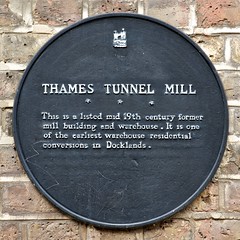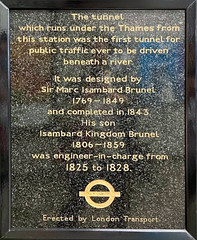

Thames Tunnel
(1825-present)
place, tunnel, and first shield-driven subaqueous tunnel
Aged 199
Wikidata WikipediaThe Thames Tunnel is a tunnel beneath the River Thames in London, connecting Rotherhithe and Wapping. It measures 35 feet (11 m) wide by 20 feet (6 m) high and is 1,300 feet (396 m) long, running at a depth of 75 feet (23 m) below the river surface measured at high tide. It is the first tunnel known to have been constructed successfully underneath a navigable river and was built between 1825 and 1843 by Marc Brunel and his son Isambard using the tunnelling shield newly invented by the elder Brunel and Thomas Cochrane. The tunnel was originally designed for horse-drawn carriages, but was mainly used by pedestrians and became a tourist attraction. In 1869 it was converted into a railway tunnel for use by the East London line which, since 2010, is part of the London Overground railway network under the ownership of Transport for London.
DbPedia
Commemorated on 4 plaques
Thames Tunnel constructed 1825-1843 first shield-driven subaqueous tunnel. Sir Marc Isambard Brunel civil engineer.
Rotherhithe tube station, London, United Kingdom where it sited (1825)
Near this spot in 1828 Isambard Kingdom Brunel was pulled half-drowned from the flooded shaft. The Thames Tunnel was abandoned for seven years and Marc Brunel sent his son to Clifton to convalesce...
Rotherhithe Street, London, United Kingdom where it sited
Thames Tunnel Mill - This is the a listed mid 19th century former mill building and warehouse. It is one of the earliest warehouse residential conversions in Docklands.
Rotherhithe Street, London, United Kingdom where it sited
The tunnel which runs under the Thames from this station was the first tunnel for public traffic ever to be driven beneath a river It was designed by Sir Marc Isambard Brunel 1769-1849 and completed in 1843 His son Isambard Kingdom Brunel 1806-1859 was engineer-in-charge from 1825 to 1828.
Rotherhithe Station , London, United Kingdom where it sited



